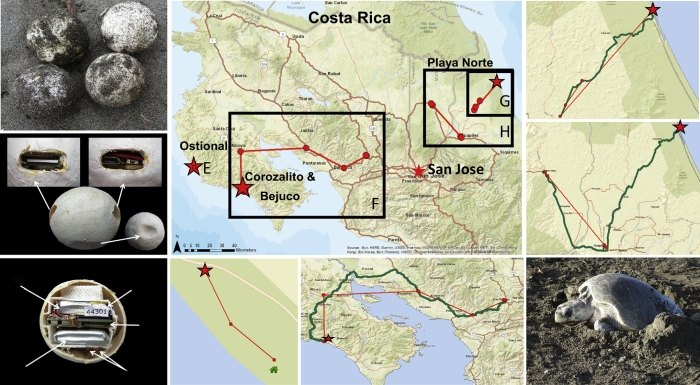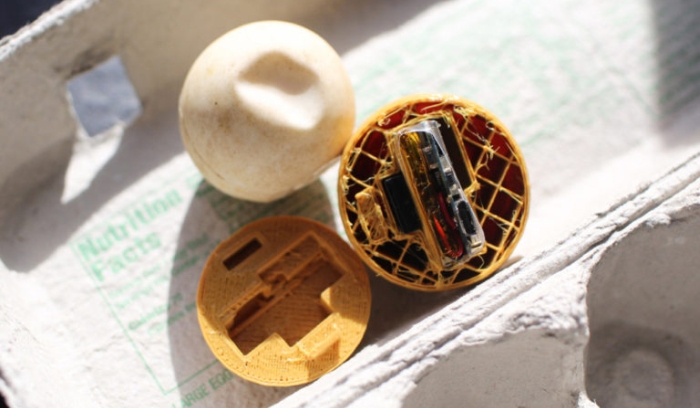If you've ever watched a wildlife documentary, you're probably familiar with the scene. Just-hatched baby sea turtles, struggling free of the sand that concealed the nest to make the treacherous trek to the water, while predatory seabirds wait to feast on the vulnerable newborns. You want to cheer as they reach the waves, having passed the first trial of their new lives.
But in Central America, it's not the first trial. Many sea turtle eggs - over 90 percent, on some beaches - never even get to hatch. They're harvested by poachers, and trafficked to cities, where they'll be fed as a delicacy to one of Earth's most dangerous predators - humans.
A new tool could help put a stop to this practice that's harming the vulnerable species. Researchers hid GPS devices in fake turtle eggs to track the journey from poacher to table, and in the first test of the technology, it totally worked.
"Our research showed that placing a decoy into a turtle nest did not damage the incubating embryos and that the decoys work," said biologist Helen Pheasey of the University of Kent in the UK.
"We showed that it was possible to track illegally removed eggs from beach to end consumer as shown by our longest track, which identified the entire trade chain covering 137 kilometres (85 miles)."
The idea for the decoy eggs, named the InvestEGGator, was conceived a few years ago in response to the United States Agency for International Development (USAID) Wildlife Crime Tech Challenge to detect wildlife trafficking transit routes.
Scientists have been using decoys to "spy" on animals for some time - like penguin-shaped robots in Antarctica, a fake baby gorilla in Africa, even, yes, eggs. They allow scientists to study animal behaviour in their natural habitat, with their guard down.
Inspired by crime shows on TV, conservation scientist Kim Williams-Guillen with Paso Pacifico thought that, if the decoy were convincing enough, they might be able to do the same with wildlife traffickers.
 (Pheasey et al., Current Biology, 2020)
(Pheasey et al., Current Biology, 2020)
"In Breaking Bad, the DEA places a GPS tracking device on a tank of chemicals to see who receives the chemicals," she said.
"In one episode of The Wire, two police officers plant an audio device in a tennis ball to surreptitiously record a suspected drug dealer. Turtle eggs basically look like ping pong balls, and we wanted to know where they were going - put those two ideas together and you have the InvestEGGator."
To test the technology, the team placed 101 realistic decoys in sea turtle nests across four Costa Rican beaches - 3D-printed globes in the shape of turtle eggs, painted to look realistic, and fitted with GPS devices, set to emit a signal once per hour. Generally, one egg per nest was deployed, since poachers usually take the entire clutch.
Of these decoys, around 25 percent were removed when the clutch was illegally stolen from the beach. The remaining decoys were left in their clutches; when the researchers checked these nests, the other eggs had hatched as normal, indicating that the decoys pose no harm to the real eggs.
 (Paso Pacifico)
(Paso Pacifico)
From the stolen eggs, the researchers were able to track five trafficked clutches - three from the vulnerable olive ridley sea turtle (Lepidochelys olivacea) and two from the endangered green sea turtle (Chelonia mydas).
The aim was not to find the poachers removing the eggs from their nests, but to follow the supply chain to find out where they end up, and how. And at this, the eggs... eggscelled.
"As trafficking is a more serious crime, those handover points are far more valuable from a law enforcement perspective than catching someone taking a nest," Pheasey said.
The shortest route one of the eggs travelled was the vicinity of a residential property. Another was tracked around two kilometres (1.24 miles) from the beach to a local bar.
The longest distance was 137 kilometres - the egg was tracked for two days to a supermarket loading bay in the Costa Rican Central Valley. From there, it made its way to a home. Since sea turtle eggs aren't sold in supermarkets, but door-to-door, the researchers assumed that the loading bay was just the handover point between the trafficker and the seller.
Even the decoy eggs that didn't work as planned started proving useful. One egg went offline near the town of Cariari, 43 kilometres (27 miles) from the nest. The team were later sent photos of the dissected egg, as well as information on the point of sale (near Tortuguero National Park) and how many eggs were sold.
This is both good and bad news. The good news is that the local community is willing to share information about turtle egg trafficking. But, their willingness to do so indicates that they don't think it's a big deal to steal and eat turtle eggs - which means that stopping it is going to be an uphill battle.
That's not really surprising. Humans have been eating sea turtle eggs for a long time. But humans are much more numerous than we used to be, and sea turtles much less. Poaching and trafficking without care for this fact is ultimately unsustainable.
What InvestEGGator offers is hope for change.
"But it really must be used in the context of a multi-pronged conservation approach that uses education," Williams-Guillen said, "building better economic opportunities, and enforcement to help fight sea turtle egg poaching."
The research has been published in Current Biology.
#Nature | https://sciencespies.com/nature/heres-how-fake-turtle-eggs-are-helping-scientists-fight-crime-in-costa-rica/
No comments:
Post a Comment